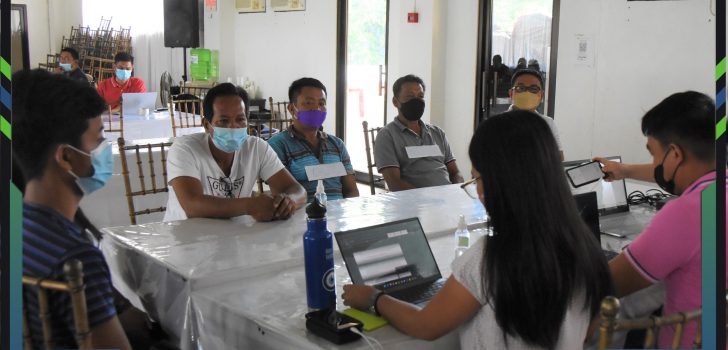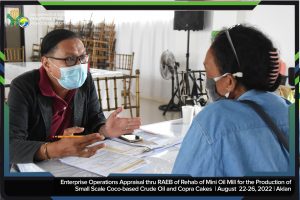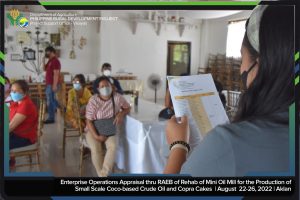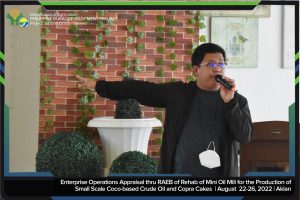
RAEB shows crude oil, copra cakes production remains as staple livelihood for Man-up coconut farmers in Aklan
The emerging benefits brought by the utilization of coconut commodity which is abundant in Altavas area processed as crude oil and copra cakes were discerned during the Rapid Appraisal of Emerging Benefits (RAEB) for the Rehabilitation of Coconut Mini Oil Mill for the Production of Small Scale Coco-based Crude Oil and Copra Cakes held by the Department of Agriculture- Philippine Rural Development Project (DA-PRDP) Regional Project Coordination Office 6 (RPCO 6) and Project Support Office (PSO) Visayas in Altavas, Aklan on August 22-26, 2022.
The five-day activity is composed of briefing and leveling off meeting with the team, breakout sessions, household survey among the 30 identified coconut farmers in the neighboring barangays, Key Informant Interview (KII) with the traders on substantiating the findings that emerged from the household survey, and spot interview with the project beneficiaries and Indigenous People (IP) in the area to capture their thoughts and experiences towards the subproject operations.
According to Ligaya Magbanua, Chieftain of Ati Community, one of the IP groups residing adjacent to the cocomill, the facility had helped them gain additional income and served as their temporary shelter in times of calamities.
“Ang amon pangabuhian gabaligya kami et hibyok ag ginadala namon sa banwa ag nabaligya ag naidalawat it bugas harun et sulod it balay agud to makakaon amon pamilya. Amon una sa lanahan nga ron, sa cocomill, ig bulig man kami kon may trabaho kag ginabaydan man. Abu man bulig sa amon, kung tulad abi kana kon maagyan kami mga bagyo tapos una kami gakaagahan ag una man kami diretso panago.”
(Our livelihood here mainly is selling brooms to the market. The income earned is what we use to buy rice and other necessities. As to the cocomill, we run some errand there whenever we are needed and we get paid. It serves several benefits to us particularly during the time of typhoons for it is our go-to place where we spend our time up until the daybreak), said Magbanua during the spot interview.
Meanwhile, the Provincial Project Management and Implementing Unit (PPMIU) focal person for I-REAP Component Frances Arnaiz shared his viewpoint on the importance of conducting the RAEB to various enterprise subprojects.
“The RAEB serves as intermediate evaluation activity that allows us to assess our different subprojects under the PRDP. This is actually a big help for both the Province and the PRDP in order to be able to give feedback to the lessons emerging upon the management and operation of the subproject. The results from this activity will guide us in making decisions and adjustments on the approaches being employed to ensure the sustainability of the project,” emphasized Arnaiz.
Spearheaded by the Monitoring and Evaluation (M&E) Unit, the processes were carried out by various DA-PRDP components and units involved. This was participated by the I-REAP Component and I-SUPPORT Component including the Geomapping and Governance Unit, Social and Environmental Safeguards, Economics Team, InfoACE Unit and the designated PPMIU officials of the Province.
Initial discussions of the results, key points, and setting of timelines were done on the last day of the week-long activity.
Currently, the team has already consolidated all the data gathered from the RAEB and is currently working on the generation of the complete report pertaining to the selected enterprise subproject.
The RAEB is one of the monitoring and evaluation activities being done to check on emerging benefits with emphasis on the processes that the subproject had gone through up until its first year of operation. Its framework uses several methodologies to gather information to validate the stream of benefits of the selected subproject. (April Grace Padilla, RPCO 6, Writer)



